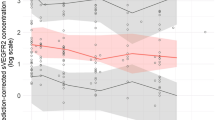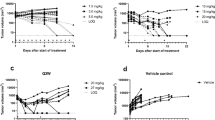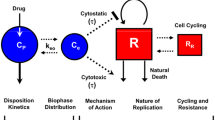Abstract
Dysregulation of mTOR pathway is common in hepatocellular carcinoma (HCC). A translational quantitative systems pharmacology (QSP), pharmacokinetic (PK), and pharmacodynamic (PD) model dissecting the circuitry of this pathway was developed to predict HCC patients’ response to everolimus, an mTOR inhibitor. The time course of key signaling proteins in the mTOR pathway, HCC cells viability, tumor volume (TV) and everolimus plasma and tumor concentrations in xenograft mice, clinical PK of everolimus and progression free survival (PFS) in placebo and everolimus-treated patients were extracted from literature. A comprehensive and multiscale QSP/PK/PD model was developed, qualified, and translated to clinical settings. Model fittings and simulations were performed using Monolix software. The S6-kinase protein was identified as critical in the mTOR signaling pathway for describing everolimus lack of efficacy in HCC patients. The net growth rate constant (kg) of HCC cells was estimated at 0.02 h−1 (2.88%RSE). The partition coefficient of everolimus into the tumor (kp) was determined at 0.06 (12.98%RSE). The kg in patients was calculated from the doubling time of TV in naturally progressing HCC patients, and was determined at 0.004 day−1. Model-predicted and observed PFS were in good agreement for placebo and everolimus-treated patients. In conclusion, a multiscale QSP/PK/PD model elucidating everolimus lack of efficacy in HCC patients was successfully developed and predicted PFS reasonably well compared to observed clinical findings. This model may provide insights into clinical response to everolimus-based therapy and serve as a valuable tool for the clinical translation of efficacy for novel mTOR inhibitors.






Similar content being viewed by others
References
Parkin DM, Bray F, Ferlay J, Pisani P (2005) Global cancer statistics, 2002. CA Cancer J Clin 55(2):74–108
El-Serag HB (2004) Hepatocellular carcinoma: recent trends in the United States. Gastroenterology 127(5 Suppl 1):S27–S34
El-Serag HB, Davila JA, Petersen NJ, McGlynn KA (2003) The continuing increase in the incidence of hepatocellular carcinoma in the United States: an update. Ann Intern Med 139(10):817–823
El-Serag HB, Mason AC (1999) Rising incidence of hepatocellular carcinoma in the United States. N Engl J Med 340(10):745–750. https://doi.org/10.1056/NEJM199903113401001
Forner A, Llovet JM, Bruix J (2012) Hepatocellular carcinoma. Lancet 379(9822):1245–1255. https://doi.org/10.1016/S0140-6736(11)61347-0
Zhu AX (2006) Systemic therapy of advanced hepatocellular carcinoma: how hopeful should we be? Oncologist 11(7):790–800. https://doi.org/10.1634/theoncologist.11-7-790
Cheng AL, Kang YK, Chen Z, Tsao CJ, Qin S, Kim JS, Luo R, Feng J, Ye S, Yang TS, Xu J, Sun Y, Liang H, Liu J, Wang J, Tak WY, Pan H, Burock K, Zou J, Voliotis D, Guan Z (2009) Efficacy and safety of sorafenib in patients in the Asia-Pacific region with advanced hepatocellular carcinoma: a phase III randomised, double-blind, placebo-controlled trial. Lancet Oncol 10(1):25–34. https://doi.org/10.1016/S1470-2045(08)70285-7
Llovet JM, Ricci S, Mazzaferro V, Hilgard P, Gane E, Blanc JF, de Oliveira AC, Santoro A, Raoul JL, Forner A, Schwartz M, Porta C, Zeuzem S, Bolondi L, Greten TF, Galle PR, Seitz JF, Borbath I, Haussinger D, Giannaris T, Shan M, Moscovici M, Voliotis D, Bruix J, SIS Group (2008) Sorafenib in advanced hepatocellular carcinoma. N Engl J Med 359(4):378–390. https://doi.org/10.1056/NEJMoa0708857
Bjornsti MA, Houghton PJ (2004) The TOR pathway: a target for cancer therapy. Nat Rev Cancer 4(5):335–348. https://doi.org/10.1038/nrc1362
Minguez B, Tovar V, Chiang D, Villanueva A, Llovet JM (2009) Pathogenesis of hepatocellular carcinoma and molecular therapies. Curr Opin Gastroenterol 25(3):186–194. https://doi.org/10.1097/MOG.0b013e32832962a1
Afinitor (everolimus) Label - FDA (2010).
Dattoli G, Guiot C, Delsanto PP, Ottaviani PL, Pagnutti S, Deisboeck TS (2009) Cancer metabolism and the dynamics of metastasis. J Theor Biol 256(3):305–310
Kirchner GI, Meier-Wiedenbach I, Manns MP (2004) Clinical pharmacokinetics of everolimus. Clin Pharmacokinet 43(2):83–95. https://doi.org/10.2165/00003088-200443020-00002
Huynh H, Chow KH, Soo KC, Toh HC, Choo SP, Foo KF, Poon D, Ngo VC, Tran E (2009) RAD001 (everolimus) inhibits tumour growth in xenograft models of human hepatocellular carcinoma. J Cell Mol Med 13(7):1371–1380. https://doi.org/10.1111/j.1582-4934.2008.00364.x
Semela D, Piguet AC, Kolev M, Schmitter K, Hlushchuk R, Djonov V, Stoupis C, Dufour JF (2007) Vascular remodeling and antitumoral effects of mTOR inhibition in a rat model of hepatocellular carcinoma. J Hepatol 46(5):840–848. https://doi.org/10.1016/j.jhep.2006.11.021
Shiah HS, Chen CY, Dai CY, Hsiao CF, Lin YJ, Su WC, Chang JY, Whang-Peng J, Lin PW, Huang JD, Chen LT (2013) Randomised clinical trial: comparison of two everolimus dosing schedules in patients with advanced hepatocellular carcinoma. Aliment Pharmacol Ther 37(1):62–73. https://doi.org/10.1111/apt.12132
Zhu AX, Abrams TA, Miksad R, Blaszkowsky LS, Meyerhardt JA, Zheng H, Muzikansky A, Clark JW, Kwak EL, Schrag D, Jors KR, Fuchs CS, Iafrate AJ, Borger DR, Ryan DP (2011) Phase 1/2 study of everolimus in advanced hepatocellular carcinoma. Cancer 117(22):5094–5102. https://doi.org/10.1002/cncr.26165
Zhu AX, Kudo M, Assenat E, Cattan S, Kang YK, Lim HY, Poon RT, Blanc JF, Vogel A, Chen CL, Dorval E, Peck-Radosavljevic M, Santoro A, Daniele B, Furuse J, Jappe A, Perraud K, Anak O, Sellami DB, Chen LT (2014) Effect of everolimus on survival in advanced hepatocellular carcinoma after failure of sorafenib: the EVOLVE-1 randomized clinical trial. JAMA 312(1):57–67. https://doi.org/10.1001/jama.2014.7189
Rohatgi A (2015) WebPlotDigitizer
Grabinski N, Ewald F, Hofmann BT, Staufer K, Schumacher U, Nashan B, Jucker M (2012) Combined targeting of AKT and mTOR synergistically inhibits proliferation of hepatocellular carcinoma cells. Mol Cancer 11:85. https://doi.org/10.1186/1476-4598-11-85
O’Reilly T, McSheehy PM, Kawai R, Kretz O, McMahon L, Brueggen J, Bruelisauer A, Gschwind HP, Allegrini PR, Lane HA (2010) Comparative pharmacokinetics of RAD001 (everolimus) in normal and tumor-bearing rodents. Cancer Chemother Pharmacol 65(4):625–639. https://doi.org/10.1007/s00280-009-1068-8
de Wit D, Schneider TC, Moes DJ, Roozen CF, den Hartigh J, Gelderblom H, Guchelaar HJ, van der Hoeven JJ, Links TP, Kapiteijn E, van Erp NP (2016) Everolimus pharmacokinetics and its exposure-toxicity relationship in patients with thyroid cancer. Cancer Chemother Pharmacol 78(1):63–71. https://doi.org/10.1007/s00280-016-3050-6
Pivonello C, Negri M, De Martino MC, Napolitano M, de Angelis C, Provvisiero DP, Cuomo G, Auriemma RS, Simeoli C, Izzo F, Colao A, Hofland LJ, Pivonello R (2016) The dual targeting of insulin and insulin-like growth factor 1 receptor enhances the mTOR inhibitor-mediated antitumor efficacy in hepatocellular carcinoma. Oncotarget 7(9):9718–9731. https://doi.org/10.18632/oncotarget.6836
Shi Y, Yan H, Frost P, Gera J, Lichtenstein A (2005) Mammalian target of rapamycin inhibitors activate the AKT kinase in multiple myeloma cells by up-regulating the insulin-like growth factor receptor/insulin receptor substrate-1/phosphatidylinositol 3-kinase cascade. Mol Cancer Ther 4(10):1533–1540. https://doi.org/10.1158/1535-7163.MCT-05-0068
Dayneka NL, Garg V, Jusko WJ (1993) Comparison of four basic models of indirect pharmacodynamic responses. J Pharmacokinet Biopharm 21(4):457–478
Chen YW, Pan HB, Tseng HH, Hung YT, Huang JS, Chou CP (2013) Assessment of blood flow in hepatocellular carcinoma: correlations of computed tomography perfusion imaging and circulating angiogenic factors. Int J Mol Sci 14(9):17536–17552. https://doi.org/10.3390/ijms140917536
Ait-Oudhia S, Straubinger RM, Mager DE (2013) Systems pharmacological analysis of paclitaxel-mediated tumor priming that enhances nanocarrier deposition and efficacy. J Pharmacol Exp Ther 344(1):103–112. https://doi.org/10.1124/jpet.112.199109
Taouli B, Goh JS, Lu Y, Qayyum A, Yeh BM, Merriman RB, Coakley FV (2005) Growth rate of hepatocellular carcinoma: evaluation with serial computed tomography or magnetic resonance imaging. J Comput Assist Tomogr 29(4):425–429. https://doi.org/10.1097/01.rct.0000164036.85327.05
Eisenhauer EA, Therasse P, Bogaerts J, Schwartz LH, Sargent D, Ford R, Dancey J, Arbuck S, Gwyther S, Mooney M, Rubinstein L, Shankar L, Dodd L, Kaplan R, Lacombe D, Verweij J (2009) New response evaluation criteria in solid tumours: revised RECIST guideline (version 1.1). Eur J Cancer 45(2):228–247. https://doi.org/10.1016/j.ejca.2008.10.026
LIXOFT Monolix (2016)
Xiang XD, Yu J, Li GF, Xie L, Li H (2014) In vitro study on blocking mTOR signaling pathway in EGFR-TKI resistance NSCLC. Asian Pac J Trop Med 7(5):394–397. https://doi.org/10.1016/S1995-7645(14)60063-8
Juengel E, Kim D, Makarevic J, Reiter M, Tsaur I, Bartsch G, Haferkamp A, Blaheta RA (2015) Molecular analysis of sunitinib resistant renal cell carcinoma cells after sequential treatment with RAD001 (everolimus) or sorafenib. J Cell Mol Med 19(2):430–441. https://doi.org/10.1111/jcmm.12471
http://huh7.com/general-information/cell-culture-information/. Accessed 12 Jan 2017
Pawaskar DK, Straubinger RM, Fetterly GJ, Hylander BH, Repasky EA, Ma WW, Jusko WJ (2013) Physiologically based pharmacokinetic models for everolimus and sorafenib in mice. Cancer Chemother Pharmacol 71(5):1219–1229. https://doi.org/10.1007/s00280-013-2116-y
Esposito I, Konukiewitz B, Schlitter AM, Kloppel G (2014) Pathology of pancreatic ductal adenocarcinoma: facts, challenges and future developments. World J Gastroenterol 20(38):13833–13841. https://doi.org/10.3748/wjg.v20.i38.13833
Pittman ME, Brunt EM (2015) Anatomic pathology of hepatocellular carcinoma: histopathology using classic and new diagnostic tools. Clin Liver Dis 19(2):239–259. https://doi.org/10.1016/j.cld.2015.01.003
Baxter LT, Zhu H, Mackensen DG, Jain RK (1994) Physiologically based pharmacokinetic model for specific and nonspecific monoclonal antibodies and fragments in normal tissues and human tumor xenografts in nude mice. Cancer Res 54(6):1517–1528
Garcia E, Becker VG, McCullough DJ, Stabley JN, Gittemeier EM, Opoku-Acheampong AB, Sieman DW (1985) Behnke BJ (2016), Blood flow responses to mild-intensity exercise in ectopic vs. orthotopic prostate tumors; dependence upon host tissue hemodynamics and vascular reactivity. J Appl Physiol 121(1):15–24. https://doi.org/10.1152/japplphysiol.00266.2016
Rashid OM, Takabe K (2015) Animal models for exploring the pharmacokinetics of breast cancer therapies. Expert Opin Drug Metab Toxicol 11(2):221–230. https://doi.org/10.1517/17425255.2015.983073
Fingar DC, Richardson CJ, Tee AR, Cheatham L, Tsou C, Blenis J (2004) mTOR controls cell cycle progression through its cell growth effectors S6K1 and 4E-BP1/eukaryotic translation initiation factor 4E. Mol Cell Biol 24(1):200–216
Hay M, Thomas DW, Craighead JL, Economides C, Rosenthal J (2014) Clinical development success rates for investigational drugs. Nat Biotechnol 32(1):40–51. https://doi.org/10.1038/nbt.2786
Seruga B, Ocana A, Amir E, Tannock IF (2015) Failures in phase III: causes and consequences. Clin Cancer Res 21(20):4552–4560. https://doi.org/10.1158/1078-0432.CCR-15-0124
Sargent DJ, Taylor JM (2009) Current issues in oncology drug development, with a focus on phase II trials. J Biopharm Stat 19(3):556–562. https://doi.org/10.1080/10543400902802474
Stroh M, Duda DG, Takimoto CH, Yamazaki S, Vicini P (2014) Translation of anticancer efficacy from nonclinical models to the clinic. CPT Pharmacomet Syst Pharmacol 3:e128. https://doi.org/10.1038/psp.2014.28
Iyengar R, Zhao S, Chung SW, Mager DE, Gallo JM (2012) Merging systems biology with pharmacodynamics. Sci Transl Med 4(126):126ps127. https://doi.org/10.1126/scitranslmed.3003563
Shah DK, Haddish-Berhane N, Betts A (2012) Bench to bedside translation of antibody drug conjugates using a multiscale mechanistic PK/PD model: a case study with brentuximab-vedotin. J Pharmacokinet Pharmacodyn 39(6):643–659. https://doi.org/10.1007/s10928-012-9276-y
Zhang XY, Birtwistle MR, Gallo JM (2014) A general network pharmacodynamic model-based design pipeline for customized cancer therapy applied to the VEGFR pathway. CPT Pharmacomet Syst Pharmacol 3:e92. https://doi.org/10.1038/psp.2013.65
Ait-Oudhia S, Mager DE, Pokuri V, Tomaszewski G, Groman A, Zagst P, Fetterly G, Iyer R (2016) Bridging sunitinib exposure to time-to-tumor progression in hepatocellular carcinoma patients with mathematical modeling of an angiogenic biomarker. CPT Pharmacomet Syst Pharmacol 5(6):297–304. https://doi.org/10.1002/psp4.12084
Tanaka C, O’Reilly T, Kovarik JM, Shand N, Hazell K, Judson I, Raymond E, Zumstein-Mecker S, Stephan C, Boulay A, Hattenberger M, Thomas G, Lane HA (2008) Identifying optimal biologic doses of everolimus (RAD001) in patients with cancer based on the modeling of preclinical and clinical pharmacokinetic and pharmacodynamic data. J Clin Oncol 26(10):1596–1602. https://doi.org/10.1200/JCO.2007.14.1127
Author information
Authors and Affiliations
Corresponding author
Ethics declarations
Conflict of Interest
The authors declare that there is no conflict of interest.
Electronic supplementary material
Below is the link to the electronic supplementary material.
Rights and permissions
About this article
Cite this article
Ande, A., Chaar, M. & Ait-Oudhia, S. Multiscale systems pharmacological analysis of everolimus action in hepatocellular carcinoma. J Pharmacokinet Pharmacodyn 45, 607–620 (2018). https://doi.org/10.1007/s10928-018-9590-0
Received:
Accepted:
Published:
Issue Date:
DOI: https://doi.org/10.1007/s10928-018-9590-0




